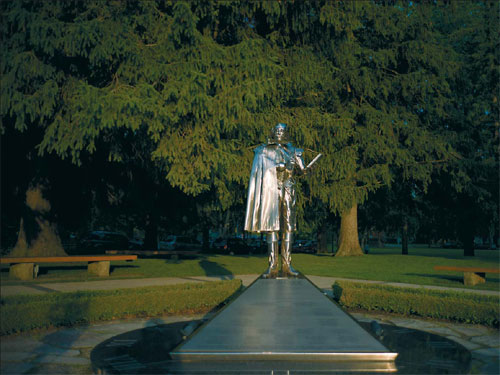Tracking the Bieb and the Bard
Updated: 2012-09-02 07:58
By Steven McElroy (New York Times Syndicate)
|
||||||||
|
A statue of William Shakespeare stands outside the Festival Theater of the Stratford Shakespeare Festival. Photos Provided to China Daily |
Pop idols separated by four centuries are drawing crowds to a small town in Ontario, Steven McElroy discovers.
On a sweltering afternoon recently, I stood in a dusty skateboard park in Stratford, Ontario, surrounded by about a dozen sullen-looking boys, all around 17. I mentioned someone they might know, someone who a few years ago used to hang out there, too, and a couple of them said he was a jerk. They could have been jealous, of course: We were discussing Justin Bieber, who not long ago was a local kid busking on the street a few blocks from this park and is now a pop star estimated by Forbes magazine to have earned $55 million, even before the release of his third full-length album, Believe.
Now I was trying to learn my way around this very small town known for the Bard and the Bieb.
Stratford, much like its most famous native son, is a town with humble beginnings that now draws hundreds of thousands of fans - or rather, tourists - for the Shakespeare festival, celebrating its 60th-anniversary season through October.
And while the festival is the main draw in town, it is not the only one; increasingly, Stratford is becoming known for its food and music culture, and of course for its homegrown pop idol.
I arrived in Stratford just as the festival's productions were beginning previews and before the crowds were there in force.
Fresh off a flight to Toronto, I rented a car for a journey of about 80 miles that takes me past farms, the Mohawk Race Track, an occasional Motel 6 and a small village called Shakespeare that predates the festival by about a century.
Stratford itself, whose population is about 32,000, has the feel of a sleepy suburb where the "everyone knows everyone" cliche could have originated.
Until you consider the festival. The annual event is a mammoth presence every April through October.
This year, a season of 14 productions is being produced on an annual budget of $60 million - enough to employ 1,000 people.
The program includes Much Ado About Nothing, Cymbeline and Henry V - all by the namesake playwright - as well as Thornton Wilder's The Matchmaker and crowd pleasers like the musical 42nd Street.
Today's festival is a far cry from its beginnings - in a single tent erected in 1953. For decades, the city had been an important railway junction, a busy hub for the Canadian National Railroad, with a maintenance yard for steam engines.
In the 1950s, when diesel began to replace steam, Stratford's key business began to ebb, and the economy did, too.
Enter the journalist Tom Patterson, who saw a Shakespeare festival as a possible savior. Though he had no background in the theater, he surrounded himself with people who did. And Alec Guinness brought star power to that opening production when he played the title role in Richard III.
The festival that Patterson spawned is now sprawling, and it would be easy to spend an entire weekend seeing shows each afternoon and evening.
Throw in a tour of the costume and prop warehouse, a visit to the festival's extensive archive - is that Christopher Walken as Romeo!? - and a stroll through the special 60th-anniversary exhibition on the festival's history, and you might miss the rest of what Stratford has to offer. That would be a mistake.
Since one of the town's major industries is catering to hordes of tourists, Stratford has a vibrant culinary culture dedicated to feeding them, much of it located around Market Square (actually a triangle), the hub of downtown.
The trick is positioning yourself near it, a strategy my partner and I followed by staying at the Three Houses, a bed-and-breakfast run by the very amiable David James Lester.

 'Taken 2' grabs movie box office crown
'Taken 2' grabs movie box office crown
 Rihanna's 'Diamonds' tops UK pop chart
Rihanna's 'Diamonds' tops UK pop chart
 Fans get look at vintage Rolling Stones
Fans get look at vintage Rolling Stones
 Celebrities attend Power of Women event
Celebrities attend Power of Women event
 Ang Lee breaks 'every rule' to make unlikely new Life of Pi film
Ang Lee breaks 'every rule' to make unlikely new Life of Pi film
 Rihanna almost thrown out of nightclub
Rihanna almost thrown out of nightclub
 'Dark Knight' wins weekend box office
'Dark Knight' wins weekend box office
 'Total Recall' stars gather in Beverly Hills
'Total Recall' stars gather in Beverly Hills
Most Viewed
Editor's Picks

|

|

|

|

|

|
Today's Top News
Health new priority for quake zone
Xi meets US top military officer
Japan's boats driven out of Diaoyu
China mulls online shopping legislation
Bird flu death toll rises to 22
Putin appoints new ambassador to China
Japanese ships blocked from Diaoyu Islands
Inspired by Guan, more Chinese pick up golf
US Weekly

|

|








